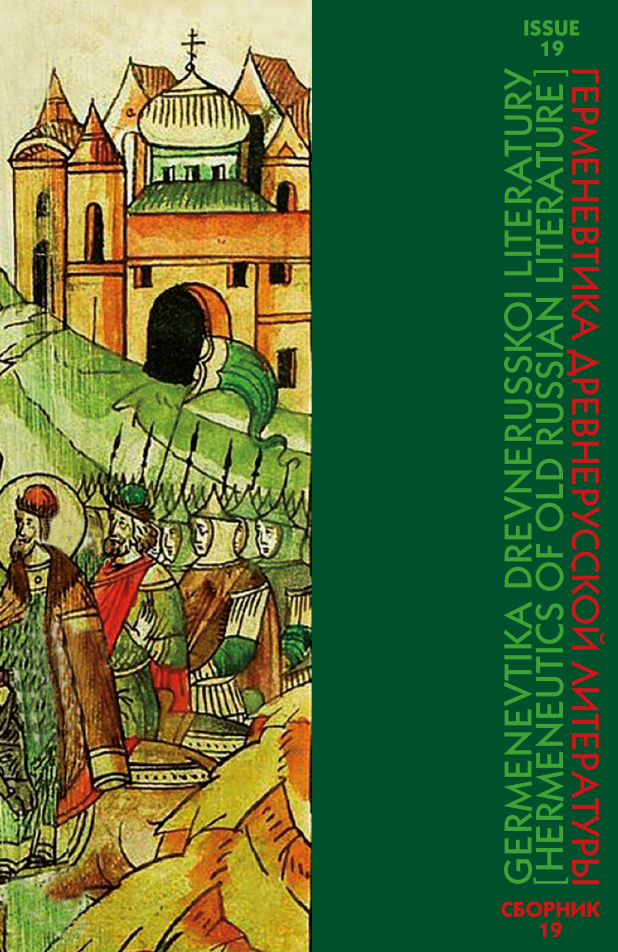Acknowledgements: The reported study was funded by Russian Foundation for Basic Research (RFBR), project number 17-29-04157.
Abstract:
The article analyzes the types of lining of Old Russian codexes. The conclusion is made that there are two main techniques of lining — tra- ditional with the use of a special awl or knife and for the first time described in Russian historiography — with the use of a template. It is concluded that when using an awl or a knife, the lining furrows can be either wide, oval or rectangular in cross-section, or narrow (angular or triangular in cross-sec- tion), depending on the tool. Observations on the nature of the location of line grooves and punctures allowed us to reconstruct the technology of preparing parchment for writing. In most cases, the two-bifol lining was used. After the 4 bifolia were folded in half, punctures were made in the fields. Then the block was again sorted into 2 sheets. The sheets of parchment were unbent again. Lining was deployed at bifolia, not one tile at a time. In the pre-Mongol peri- od, in most of the studied manuscripts, there is a clear difference in the color of the hair (darker and yellowish) and flesh (lighter) sides. At a later time, the technology changed significantly, and in codexes, created in the period from the second half of the 13th–15th centuries differences between the flesh and hair sides are practically not observed, as a result of which the so-called Gregory’s rule is not executed. The article also analyzes the technique of template lining of parchment manuscripts. The earliest known case of this type of lining is recorded in the copy of Izbornik (Anthology) of 1073 year, which was created in Moscow back to 1403. The appearance of template technology significantly diversified the lining schemes.
References:
- Dzhurova, “Rol’ Vizantii v oformlenii slavianskogo kodeksa (glagolicheskogo i kirillicheskogo): Problemy retseptsii” [“The Role of Byzantium in the Decoration of the Slavic Code (Glagolitic and Cyrillic): Problems of Reception”]. Trudy Otdela drevnerusskoi literatury [Proceedings of the Department of Old Russian Literature], vol. 62. St. Petersburg, Nauka Publ., 2014, pp. 628–643. (In Russian)
- Kazbekova, V. “Razmetka lista v srednevekovykh latinskikh rukopisiakh: rabochaia gipoteza” [“Leaf Layout in the Medieval Latin manuscripts: a Working Hypothesis”]. Srednie veka, vol. 76, no. 3–4, 2015, pp. 193–229. (In Russian)
- Kruglov, A.K. “K voprosu o tipologii russkogo perepleta: pereplet ‘v zatylok’.” [“To the Question of the Typology of Russian Binding: Binding ‘v zatylok’.”]. Vspomogatel’nye istoricheskie distsipliny v sovremennom nauchnom znanii: Materialy XXIX Mezhdunarodnoi nauchnoi Moskva, 13–15 apr. 2017 g. [Auxiliary Historical Disciplines in the Modern Scientific Knowledge: Materials of the XXIX International Scientific Conference. Moscow, 13–15 April, 2017]. Moscow, IVI RAN Publ., 2017, pp. 400–403 (In Russian)
- Mokrecova, P., and Naumova, M.M., and Kireeva, V.N., and Dobrynina, E.N., and Fonkich, B.L. Materialy i tekhnika vizantiiskoi rukopisnoi knigi (po restavratsionnoi dokumentatsii Gosudarstvennogo nauchno-issledovatel’skogo instituta restavratsii)) [The Materials and Techniques of the Byzantine Manuscript (according to the Restoration Documentation of the State Research Institute of Restoration)]. Moscow, Indrik Publ, 2003. 320 p. (In Russian)
- Mol’kov, A. “Osobennosti iazyka i pis’ma Pogodinskogo evangeliia (RNB, Pogod. 11)” [“The Features of the Language and Writing of the Pogodin Gospel (RNL, Pogod. 11)”]. Die Welt der Slaven, Jg. LXI, Heft 2, 2016, pp. 230–253. (In Russian)
- Morozova, E.I. “Kodikologiia i dekoratsiia Sluzhebnoi Minei na avgust kontsa XI — nachala XII vv. (RGADA. 381. № 125). Issledovanie v protsesse restavratsii” [“The Codicology and Decoration of the Liturgical Menaion for August of the Late 11th — Early 12th Centuries. (RSAAA. F. 381. № 125). A study in the process of restoration”]. Paleografiia, kodikologiia, diplomatika: Sovremennyi opyt issledovaniia grecheskikh, latinskikh i slavianskikh rukopisei i dokumentov: Materialy Mezhdunar. nauch. konf. Moskva, 27–28 fevr. 2013 [Paleography, Codicology, Diplomacy: Modern Experience in the Study of Greek, Latin and Slavic Manuscripts and Documents: Materials of the International Scientific. conf. Moscow, 27–28 February, 2013]. Moscow, 2013, pp. 320–367 (In Russian)
- Ukhanova, E.V. “O forme ob”edineniia drevnerusskikh pistsov v kontse XI — nachale XII v.” [“On the Form of Association of Old Russian Scribes in the Late 11th — Early 12th Century”]. Issledovaniia po paleografii, kodikologii i diplomatike [Montfaucon. Studies in Paleography, Codicology and Diplomacy]. Мoscow, ID YASK Publ., pp. 523–574. (In Russian)
- Ukhanova, V. “Kodikologicheskie osobennosti rukopisei novgorodskogo arkhiepiskopskogo skriptoriia poslednei chetverti XIII–XIV vv.: Klimentovskaia i Vasonof ’evskaia Kormchie (GIM. Sin. 132 i Chud. 4)” [“Codicological Charac- teristics of the Manuscripts from the Novgorodian Archbishop’s Scriptorium in the Last Quarter of the 13th–14th Centuries: Klimentian and Varsonofyevian Kormchaja Books (SHM. Sin. 132 and Chud. 4)”]. Spetsial’nye istoricheskie distsipliny, no. 2. Moscow, IVI RAS Publ., 2018, pp. 320–367. (In Russian)
- Ukhanova, V. “Zapadnoevropeiskoe vliianie v knizhnom proizvodstve Drevnei Rusi XI–XIV vekov: K postanovke problemy” [“The Western European Influence in the Book Production of Old Russia of the 11th–14th Centuries: to the Problem Statement”]. Srednie veka, vol. 79, no. 1, 2018, pp. 9–35. (In Russian)
- Shvarc, M. Novgorodskie rukopisi XV veka: kodikologicheskoe issledovanie rukopisei Sofiisko-Novgorodskogo sobraniia Gosudarstvennoi publichnoi biblioteki im. M.E. Saltykova-Shchedrina [Novgorod Manuscripts of the 15th Century: a Codicological Study of the Manuscripts of the Sofia-Novgorod Collection of the State Public Library named after M.E. Saltykova-Shchedrin]. Mosсow, Leningrad, Institut istorii SSSR Publ., 1989. 200 p. (In Russian)
- Dzhurova, Aksiniia. V”vedenie v slavyanskata kodikologiya [The Introduction to Slavic Codicology: the Byzantine Сode and its Reception among the Slavs]. Sofia, Sibal , 1997. 416 p. (In Bulgarian)
- Dzhurova, Aksiniia. V sveta na r”kopisite [The World of the Manuscript]. Sofia, Kliment Ohridsky Publ., 2007. 472 p. (In Bulgarian)
- Leroy, Les Types de Reglure des Manuscrits Grecs. Paris, C.N.R.S., 1976. xxxii 61 p. (In French).
- Leroy, “Quelques Systemes de Reglure des Manuscrits Grecs.” Studia codicologica. Berlin, 1977, pp. 291–312. (In French)






